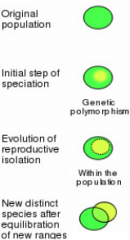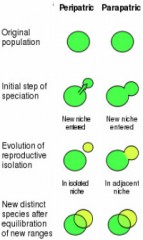![]()
![]()
![]()
Use LEFT and RIGHT arrow keys to navigate between flashcards;
Use UP and DOWN arrow keys to flip the card;
H to show hint;
A reads text to speech;
34 Cards in this Set
- Front
- Back
|
Explain Darwin's theory of 'Descent with Modification'. |
- Biological populations change over successive generations - Life evolved from a common ancestor - History of life is like a tree with branches representing thediversity of life |
|
|
What is 'Natural selection' |
- Gradual, non-random process by which biological traitsbecome more or less common in a population throughdifferential reproductive success = fitness |
|
|
What are the propositions underlying Darwin's theory of evolution through natural selection? |
- More individuals are produced than can survive - There is therefore a struggle for existence; AKA competition - Individuals within a species show variation - Those with advantageous traits will survive and reproduce - Favourable traits will accumulate over generations - Changes in environment can lead to new traits being advantageous |
|
|
What is 'Sexual selection'? |
- Animals develop features to help themto maximise their reproductive success Key to Darwin’s theory of Sexual Selection; - By making themselves attractive to the opposite sex (intersexual selection,between the sexes - By intimidating, deterring or defeating same-sex rivals (intrasexual selection,within a given sex) |
|
|
What is 'Artificial selection'? |
- Intentional breeding for certain traits,or combination of traits = Domestication - Human preferences/selective breeding - Used by Darwin as analogy to natural selectione.g. fancier pigeons |
|
|
What are the differences between Archaea and Bacteria? |
Archaea; - Archaea are prokaryotic cells - Membranes of branched hydrocarbonchains attached to glycerol by ether linkages -Cell walls contain no peptidoglycan - Not sensitive to some antibiotics that affectthe Bacteria, but are sensitive to someantibiotics that affect the Eukarya - Unique ribosomal RNA Bacteria; - Bacteria are prokaryotic cells - Membranes of unbranched fatty acid chainsattached to glycerol by ester linkages - Cell walls contain peptidoglycan - Sensitive to traditional antibacterial antibioticsbut are resistant to most antibiotics thataffect Eukarya - Unique ribosomal RNA |
|
|
What does 'symbiosis' mean? |
- Interaction between two different organisms living in close physical association, typically to the advantage of both. |
|
|
What are the three types of symbiosis? |
Mutualism; - Both the symbiont and host benefit Commensalism; - The symbiont benefits with little effect on the host Parasitism; - The symbiont benefits to the detriment of the host. |
|
|
What are Mendel's laws? |
Law of dominance; - In a cross of parents thatare pure for contrasting traits, only one formof the trait will appear in the next generation Law of segregation; - During the formation ofgametes (egg, sperm), the two allelesresponsible for a trait separate from each other. Alleles are then recombined at fertilisation,producing the genotype for the trait of theoffspring Law of independent assortment; - Alleles for different traits are distributed togametes (and offspring) independently of oneanother - Mendel bred true breeding plants with yellowround seeds (YYRR, gamete YR) against greenwinkled seeds (yyrr, gamete yr) - F1 had genotype YyRr and yellow round seedphenotype - F2 showed phenotypes in ratio of 9:3:3:1consistent with an independent assortmentmodel |
|
|
What is the 'Chromosome theory of inheritance'. |
- The nuclear substance controls the form and functionof every cell, and divides at mitosis to give equalproducts - Eggs must lose half their nuclear substance in the polarbody before fertilization, and this must be replacedexactly by the nuclear substance of the sperm - Because sexual reproduction depends on addingtogether the egg and sperm nuclei in every generation,there must be a halving of the nuclear substance in bothmale and female germ cells - There are no essential differences between thenuclear substance of eggs and sperm - Sexual reproduction is a means of producing variabilitybetween individuals, on which natural selection can act |
|
|
Explain the different ways in which gene mutations can affect an individual. |
Advantageous; - Give a selective advantage andpassed on to offspring Selectively Neutral Mutations; - No effect andare passed to offspring - also known as SilentMutations Deleterious; - Harmful and result in the death ofthe cell or individual, normally prior toreproduction |
|
|
What is the Hardy-Weinberg equilibrium used to calculate? |
- Predicted frequencies of genotypes underthe hypothesis that population is not evolving - Compare predicted values to the real (measured)ones to check if the population is evolving or not.HW equilibrium allows to detect if evolutionaryforces are acting upon a population |
|
|
What is a Bottleneck effect in relation to genetic drift? |
- If size of a population isreduced drastically and quicklythe progeny of survivors mighthave allele frequencies differentfrom those of the originalpopulation |
|
|
What is the 'Founder effect'? |
- A few individuals from a population start a newpopulation with allele frequencies different fromthe original one |
|
|
When does 'Gene flow' occur? |
- When individuals from one distinctpopulation move to another, interbreed, so bringing adistinct set of alleles to the recipient population |
|
|
What are the four main discoveries that led to modern synthesis? |
- Macroand Micromutations and Genetics of Populations - Mutational analysis - Taxonomy and population genetics - Palaeontology |
|
|
What is a macromutation and what is a micromutation? |
Macromutation; - A mutation of large phenotypic effect; one that produces a phenotype well outside the range of variation previously existing in the population. Mutations with effects in early stages of development can have large phenotypic consequences Micromutation; - A small-scale or highly localised mutation; especially: one involving alteration at a single gene locus (point mutation) |
|
|
What is mutational analysis? |
- Gene mutation analysis is now a fundamental part of the investigation and management of an individual and their family with an inherited disorders - Its a look at a mutation found in DNA - These mutations can be found via PCR |
|
|
What are the main points for taxonomy and population genetics? |
- Genotype not phenotype determinesa species - Natural populations are genetically variable - Differences between species and populations can be experimentally shown to have a geneticcomponent. Most are polygenic - Natural selection does occur in natural populations - Speciation occurs when geographically separate populations become geneticallydifferent |
|
|
Does palaeontology support or appose evolution? |
- It shows morphology does change - It shows that these changes maybe gradual over a long time - But It also shows change mayhappen rapidly over few generations |
|
|
What are the rules of the modern synthesis? |
- Genetic variation in populationsarises by chance through mutation, gene segregation and recombination - Evolution consists of changes inthe frequency of alleles between one generation and anotherdue to genetic drift, gene flow and naturalselection - Most genetic changes haveindividually slight phenotypic effect - Diversification comes about by speciation |
|
|
What are the differences between Darwin and Modern Synthesis? |
- It recognizes several mechanismsof evolution in addition to natural selection - It recognizes that characteristics are inherited as discrete entities called genes. Variationwithin a population is due to the presence ofmultiple alleles of a gene - Itpostulates that speciation is (usually) due to the gradual accumulation of small genetic changes. This is equivalent to saying that macroevolution is simply a lot of microevolution |
|
|
What is the Biological species concept? |
- "Species are groups of interbreedingnatural populations that are reproductively isolatedfrom other such groups“ - Must produce viable fertile offspring |
|
|
What isolation mechanisms exist? |
Prezygotic barriers: no chance to mate - Geographic isolation - Mechanical isolation - Temporal isolation - Behavioural isolation Postzygotic barriers: incomplete fertilisation or not fertile hybrids - Gamete incompatibility - Hybrid mortality - Hybrid breakdown - Hybrid infertility |
|
|
What is hybridisation and speciation? |

- Formation of new species or ‘extinction’ (fusion)of 2 and more species |
|
|
What is the phylogenetic species concept? |
- Species are a group oforganisms whose membersdescended from a commonancestor and who all possess acombination of certain defining,or derived, traits - Uses the concept ofcladogenesis (branching ofspecies) - Morphological species concept |
|
|
What are the features leading to speciation? |
1) Variation 2) Isolation 3) Decreased gene flow 4) Selection 5) Divergence 6) Speciation |
|
|
What is 'Allopatric speciation'? |
- Speciation bygeographic isolation - Barriers prevent two or more populationsfrom mating leading to separation |
|
|
What is the difference between Vicariance and Dispersal? |
Vicariance; - The geographical seperation of a population, typically by a physical barrier such as a mountain range or river, resulting in a pair of closely related species. New species form on each side. Dispersal; - a population migrates over an already existing geographic formation, creating a new species, whilst the old one stays rhe same |
|
|
What is 'Sympatric specifation'? |

- New species evolvefrom a single ancestral species whileinhabiting the same geographic range. |
|
|
What is 'Peripatric/Parapatric speciation'? |

- Smallperipheral populations which exploit adifferent niche - Peripatric similar to allopatric - Parapatric similar to sympatric |
|
|
What is an 'Ecological niche'? |
- The rolethe species plays in theecosystem and includes thetype of food it eats, where itlives, where it reproduces, andit relationships with otherspecies. |
|
|
What is the difference between a "fundamental (theoretical)" and the "realised" niche? |
Fundamental (theoretical)niche; - Full range ofenvironmental conditions andresources an organism canpossibly occupy and use,without limiting factors Realised (actual) niche; - Partof fundamental niche that anorganism occupies as a resultof limiting factors present |
|
|
What are the forces of evolution? |
- Mutations - Genetic drift - Selection - Migration (gene flow) |

